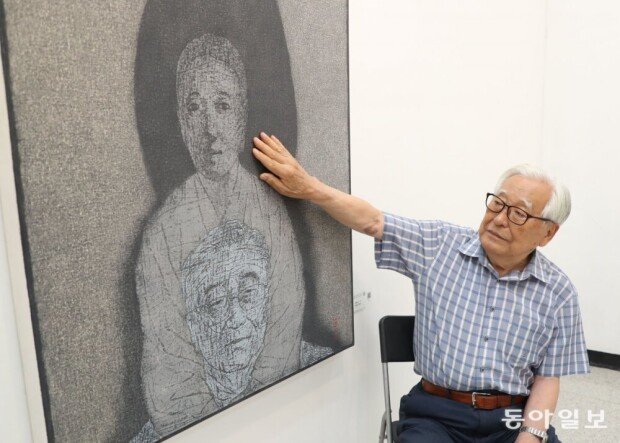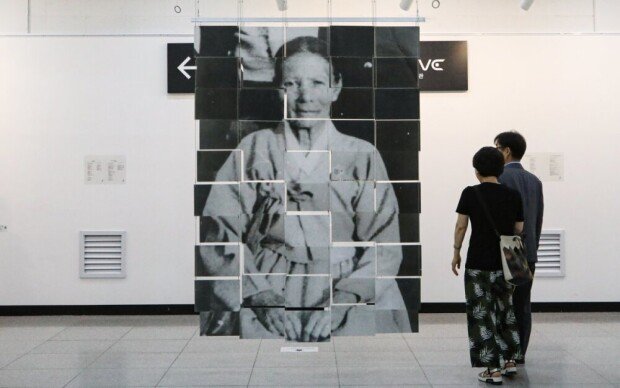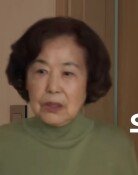56 faces of divided families who are deeply missed
56 faces of divided families who are deeply missed
Posted July. 27, 2023 08:14,
Updated July. 27, 2023 08:14


Sim Gu-seob, 89, gave a gentle pat on his mother who separated with him with his fingers trembling. A 13-year-old boy has grown old to be this gray-haired old man standing with his tearful eyes in front of a painting depicting his mother who still looks young with no wrinkles on her face. “Have a great day,” she said to the boy who got off to school one morning, the last time he could see his mother before she left northward to bring to the South his brother, who was waiting for his family alone. “I can vividly remember the day when she got my school uniform ironed to have me wear it and waved to me outside of the house,” he recalled.
On Tuesday, two days before the 70th anniversary of the Armistice Agreement, Sim visited a special exhibition that opened last Monday at the Korean Peninsula Ecological Peace Tourist Center. He is one of the many first-generation families who were separated during the war. His yearnings built over more than seven decades for his beloved mother only got deeper while he looked at “Silent River,” a painting describing him as giving his mother a piggyback. Born in Sinsang near Hamhung in South Hamkyong Province, he moved to the South with his parents in September 1947. On the first morning when he went to Gangneung Normal Middle School, his mother returned to their old house in the North to bring his brother to the new place.
Professor Lee Man-soo at the Department of Oriental Painting of Sungshin Women's University worked on this painting for three months based on Sim’s personal accounts. He said, “This piece alone is never enough to heal the wounds of divided families but represents the wishes of the son and his mother to live together.”
This free-of-charge exhibition, available by Aug. 20, features the art project “Faces We Miss” involving 56 pieces produced by sculpture artists, painters, and photographers to deliver the stories of first-generation divided families. Since the project was launched in 2017, 56 pairs of artists and divided family members have been part of the works. Left on hold for more than two and a half years during the pandemic, it was resumed this month. Executive Director Ha Jong-gu of Wishes in All, an organization in charge of the project, commented that its crews thought over what they could do as artists living in the divided country and decided to join hands with like-minded souls.
Thanks to this project, Kim Myung-cheol, an 87-year-old man born in Pukchong-gun in South Hamkyong Province, recalled his old days in his hometown. In a telephone interview last Friday, he said he could remember Dec. 7, 1950 – the day he left his hometown. After a siren went off, he, 14, promised his mother and elder brother in front of the gate that he would return in a week, but his words were never kept. What’s worse, a sack of rice where he hid his family picture got stolen at Hungnam dock during the refugee evacuation in December 1950. He confessed that he tried to keep his personal story untold to erase the stolen memories with his family, adding, “I tried to pretend that I have no memories at all to make myself feel okay.”
Lee Ik-tae, 76, talked to Kim and noticed him smiling just like a little boy when recalling learning to play the small drum sogo from school. This is how the artist drew Kim holding a sogo. “I have left behind all the memories of my hometown throughout my lifetime,” Kim said while looking at the painting. “This piece is the only one that I have in mind.”
Yoon Il-yeung, an 87-year-old man who lost his hometown and currently lives in Dongdaemun-gu, Seoul, first talked to Kim Seo-kyung, a sculpture artist part of this project, last Saturday. He came from Oeum-ri, Jangdo-myeon, Jangdan County, Gyeonggi Province, one of the South’s unrecovered territories, which is clearly seen over the truce line from an observatory platform installed on the hills around the Tomb of King Gyeongsun in Yeoncheon-gun, Gyeonggi Province. “I wish I could take only a single step onto the hill at the back of my hometown village, which I can see from here,” Yoon said. Wishes in All announced that it would continue to hold exhibitions to deliver stories of more than 250 divided family members and displaced people.
always99@donga.com







